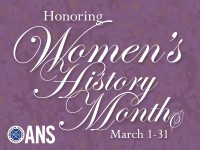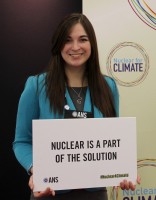Women’s History Month & Nuclear Physicist Katharine Way
 Happy Women's History Month! Each week during the month of March, one woman from the history of nuclear science and technology will be featured on the ANS Nuclear Cafe.
Happy Women's History Month! Each week during the month of March, one woman from the history of nuclear science and technology will be featured on the ANS Nuclear Cafe.
As a woman and a nuclear engineer myself, I am honored to have so many female role models to look up to. Many incredible female physicists and engineers blazed the path for me and the women around me to succeed, and we honor their legacy as we begin to build our own.
However, with nuclear engineering comprised of only about 11.5% women, I believe we should also push ourselves to do better and encourage more girls to enter this field. Sharing stories of women in nuclear, including the ones that will be posted on the ANS Nuclear Cafe throughout the month of March, is both a celebration of women's history and inspiration for the future.
You probably know the story of Marie Curie, but do you know the story of Dr. Katharine "Kay" Way? Born in 1903, Katharine Way was a nuclear physicist who made significant contributions to the Manhattan Project and the field of nuclear data.
Dr. Way received a B.S. in physics from Columbia University in 1932 and earned a Ph.D. from University of North Carolina in 1938 for her dissertation on the Photoelectric cross section of the deuteron [2]. Her 1939 paper on the Liquid-Drop Model and Nuclear Moments noted instability in rapidly spinning cigar-shaped nuclei and came close to theorizing nuclear fission, according to her advisor.
She became an assistant professor at the University of Tennessee in 1939. However, war soon broke out and in 1942 she joined the Metallurgical Laboratory in Chicago and became a part of the Manhattan Project. In Chicago and later at Oak Ridge, her work contributed to reactor design and she developed the Way-Wigner approximation of fission product decay with physicist Eugene Wigner.
After the war, Dr. Way co-edited the book One World or None: A Report to the Public on the Full Meaning of the Atomic Bomb featuring Albert Einstein, Neils Bhor, Arthur Holly Compton, Robert Oppenheimer, and more. It became a New York Times bestseller and focused on the implications of nuclear weapons.
Dr. Way also came up with an idea for the Oak Ridge Institute of Nuclear Studies (now known as Oak Ridge Associated Universities), to increase collaboration and allow for universities in the south to have access to the unique research facilities that Oak Ridge offered.
After the war, she went to work for the National Bureau of Standards in Washington D.C. According to her Ph.D. advisor John Wheeler, she was the "authority on nuclear data, nuclear energies, and probabilities of transformation". Dr. Way recognized the importance of nuclear data, creating the Nuclear Data Project under the U.S. National Academy of Sciences in 1953. The Nuclear Data Project eventually lead to the academic journals "Nuclear Data Sheets" and "Atomic Data and Nuclear Data Tables," both of which still exist today.
Dr. Way returned to North Carolina in 1968 to work at the Triangle Universities Nuclear Laboratory and become an adjunct professor at Duke University. She remained active in editing journals until just before her eightieth birthday.
In her obituary in 1995, it was noted that Dr. Way was also passionate about social justice, including the civil rights movement in the 1960s and the health of older adults in North Carolina.
References:
Teaching Katharine Way at the University of North Carolina[Video file]. (2008). Web of Stories. Retrieved from https://www.webofstories.com/playAll/john.wheeler?sId=9414. Story first recorded in December 1996
Jack, J. (2009). Science on the home front: American women scientists in World War II. Urbana (Ill.): University of Illinois Press.
Landivar, L. (2013, September). Disparities in STEM Employment by Sex, Race, and Hispanic Origin(Rep. No. ACS-24). Retrieved February 27, 2018, from American Community Survey Reports, U.S. Census Bureau website: https://www.census.gov/prod/2013pubs/acs-24.pdf
Way, K., & Wigner, E. P. (1948). The Rate of Decay of Fission Products. Physical Review,73(11), 1318-1330. doi:10.1103/physrev.73.1318
Way, K. (1937, April 1). Photoelectric cross section of the deuteron (Doctoral dissertation, University of North Carolina, 1938). Physical Review Journals,51(7). doi:https://doi.org/10.1103/PhysRev.51.552
Way, K. (1939). The Liquid-Drop Model and Nuclear Moments. Physical Review,55(10), 963-965. doi:10.1103/physrev.55.963
Wheeler, J. A., & Ford, K. W. (2000). Geons, black holes, and quantum foam: a life in physics. New York: Norton.
 Katie Mummah is a nuclear engineering graduate student at the University of Wisconsin-Madison. She serves as the current ANS Student Director, representing all ANS student members on the ANS Board of Directors. She has been a scholarship recipient several times and is extremely grateful for the ANS scholarship program-and wants you to win as well!
Katie Mummah is a nuclear engineering graduate student at the University of Wisconsin-Madison. She serves as the current ANS Student Director, representing all ANS student members on the ANS Board of Directors. She has been a scholarship recipient several times and is extremely grateful for the ANS scholarship program-and wants you to win as well!

